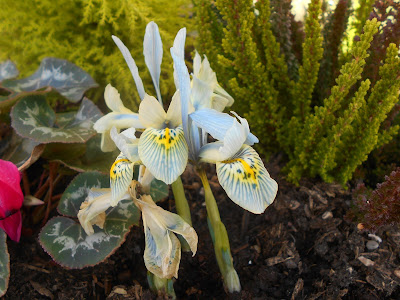The narcissi have been present for as long as I can remember and appear to have spread a little.
 |
The clumps of narcissi are small but seem to be spreading.
Byfield Pocket Park, 3 February, 2020
|
 |
The colony of croci under a central oak provided a splash of colour.
Byfield Pocket Park, 3 February, 2020
|
I confess to only taking a glance but I suspect they are Crocus chrysanthus, a native of Turkey and the Balkans. It is sometimes referred to as the Snow Crocus, being a particularly early flowerer. Bees will visit the flowers for pollen but, as I have said, not today.
The 'lambs tail' catkins on the hazel bushes have been out for some time and in some cases were turning brown. I kept an eye open for distorted catkins as they are often an indication of attack by mites, but I found none.
The 'lambs tail' catkins on the hazel bushes have been out for some time and in some cases were turning brown. I kept an eye open for distorted catkins as they are often an indication of attack by mites, but I found none.
 |
Bright sun made hazel catkins appear almost luminous.
Byfield Pocket Park, 3 February, 2020
|
The oak trees proved more interesting with two very obvious galls present. One was predictably the Oak Marble Gall, caused by a cynipid wasp Andricus kollari. The second was more common but proved a little trickier to spot. It is known as the Ramshorn Gall but in this example the gall looks more like a spring onion in shape. Again it is the work of a cynipid wasp, Andricus aries and occurs only on oak.
 |
The Ramshorn Gall often has curved 'horns' but not in this case.
Byfield Pocket Park, 3 February, 2020
|
I had decided not to take any collecting equipment with me. This decision was logical as I had several other things to carry but it became frustrating as I exposed several interesting beetles when lifting loose bark on sycamore trees.
-------------------------------
So, here I am, two days later. Chris is visiting her friend Julie Ferguson and I, properly equipped, am hoping to pick up where I left off. The sycamore trees had not run away and this time I am armed with my trusty pooter Within five minutes I had successfully secured a beetle specimen from beneath bark.
It proved to be Calodromius spilotus. The name is derived from the Greek kalos, beautiful, dromas, a runner and spilos, a spot. This rather common species, like those of its close relatives, is distinctly flattened and rather wedge-shaped, allowing it to insinuate itself beneath close-fitting bark.
 |
Specimens of Caladromius spilotus were very common beneath loose bark.
Byfield, Northants, 5 February, 2020
|
Several other insects turned up including a Hawthorn Shieldbug and, on the tree trunk, a Green Shieldbug, Palomena prasina.
 |
Removing loose bark also revealed a Hawthorn Shieldbug.
Byfield, 5 February, 2020
|
Despite its common name the Green Shieldbug was a dull brown. It will retain this colour until winter is over and will then turn green and so be inconspicuous against foliage.
 |
A Green Shieldbug was still in its brown winter colours.
Byfield, Northants, 5 February, 2020
|
With a Winter Gnat, a mirid bug and a tiny beetle yet to be properly identified I was well pleased with my morning's efforts - but by heck it was cold!
 |
A group of Iris reticulata which I believe to be the form known as
'Eye Catcher' aroused feelings of envy when I spotted it in a Byfield garden.
5 February, 2020
|
No comments:
Post a Comment